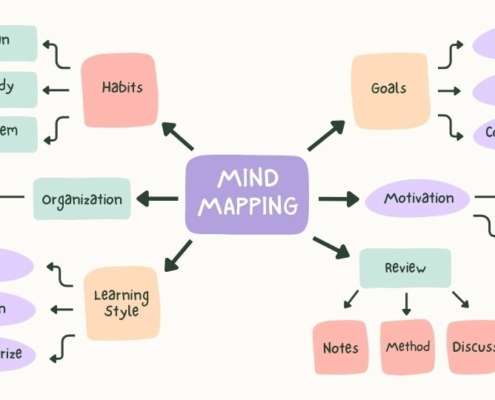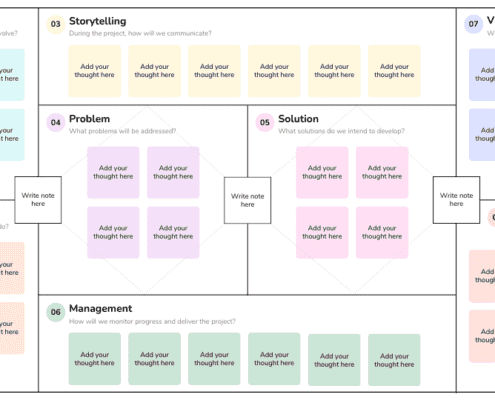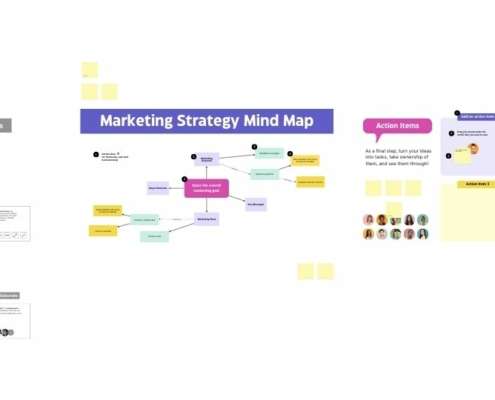Have you ever found yourself drowning in a sea of ideas, unsure how to tackle complex problems, or just looking for a creative way to brainstorm? Then you have probably heard of a magical tool: The Mind Map. But what is it? And how do you use it?
The main points we will cover in this article (click to jump directly to the subtopic):
- Mind Mapping Definition
- Why Mind Mapping works (Science backed)
- How-To Guide
- Examples of Mind Maps
- Other Use-Cases
- Common Mistakes to Avoid
- And more…
Mind Mapping Definition
Before we dive into the practical aspects, it’s crucial to first understand what a mind map truly is.
In its essence, a mind map is a visual representation of thoughts, concepts, or information organized around a central idea.
Picture it as a tree with branches, where the central idea serves as the trunk, and branches extend outward, representing subtopics and ideas related to the central theme. What sets mind maps apart is their non-linear structure, which mimics the way our minds naturally work. This flexible and creative approach allows you to capture thoughts in a free-flowing manner, making it a powerful tool for brainstorming, problem-solving, and organizing information.

A brief History
Mind mapping as we know it today owes its inception to the brilliant mind of Tony Buzan, a British author and educational consultant. In the 1960s, Buzan introduced this innovative method to the world, advocating for a more creative and effective way of capturing and organizing ideas. However, it’s important to note that the concept of visually representing information dates back much further, with roots in ancient civilizations. Throughout history, notable thinkers, from Leonardo da Vinci to Albert Einstein, utilized visual diagrams and drawings to unlock their creativity and solve complex problems. These historical precursors paved the way for the development of modern mind mapping techniques.
The Primary Purpose of Mind Mapping
So, what’s the primary purpose of creating mind maps, and why are they so valuable? At its core, mind mapping is a versatile tool with a multitude of applications. It can:
- Help you brainstorm ideas
- Plan projects
- Take notes
- Learn and retain information
- Enhance your problem-solving abilities
Whether you’re a student looking for a more effective way to study or a professional aiming to streamline your work processes, mind maps offer a creative and efficient approach to achieve your goals. The primary purpose of creating mind maps is to tap into your innate creativity and provide a visual structure for organizing your thoughts, making it easier to comprehend complex concepts and see connections between ideas. In the subsequent sections of this article, we’ll uncover just how this versatile tool can be applied in various aspects of life, from self-development to team collaboration.
Why Mind Mapping works (Science backed)
One of the remarkable strengths of mind mapping lies in its ability to bring order to chaos. We’ve all experienced moments when our thoughts seem scattered and disjointed, making it challenging to tackle projects or solve problems. Mind maps, with their interconnected branches and central focus, help us untangle the web of our thoughts and ideas. They provide a clear structure for organizing information and making sense of the bigger picture. This structural clarity aids not only in personal endeavors but also in professional contexts where efficient decision-making and idea development are essential.
Several studies have focused on the potential of mind mapping, providing valuable insight into the benefits of this technique. Some key-findings:
- “Medical students using mind maps can successfully retrieve information in the short term” – Source
- “Mind mapping is a viable active learning strategy to promote critical thinking in PA students” – Source
- “Mind maps provide an effective study technique when applied to written material” – Source
- “Our findings suggest that MBL teaching approach (Mind Mapping Problem Based Learning) can help in integration of knowledge structure and enhance clinical reasoning” – Source
Mind Map How To
To create your very first mind map, start with a blank sheet of paper or a digital canvas. In the center of the page, write down your central idea. This idea will serve as the core of your mind map. From there, let your thoughts flow freely. Create branches radiating from the central idea and label them with related concepts or keywords. These branches can also have sub-branches, further breaking down the information. Don’t worry about making it perfect; mind maps are meant to be fluid and creative, so there’s no strict structure to follow.
To make your mind maps more effective, consider using color-coding. Assign specific colors to different branches or concepts to visually group related ideas. This will make it easier to follow the flow of your mind map. Symbols and icons can also enhance your mind maps. For example, use an exclamation mark to indicate important points or a lightbulb for creative ideas. By using these practical techniques, you’ll create mind maps that are not only informative but also visually appealing and easy to understand.
Tools and Software for Mind Mapping
If you prefer digital tools, you can explore a variety of options. Some popular choices include Lucidspark, XMind, or even simple tools like Microsoft OneNote or Google Drawings. These digital platforms offer features to help you create, edit, and share your mind maps efficiently. Choose the one that aligns with your preferences and start experimenting.
Tip: At teamazing we use Miro extensively as our mind mapping tool. It is highly effective as a collaborative tool, helping to bring together the best ideas from the team. This approach was a game-changer during our transition to virtual teams.

Complex Applications: Project Management and Problem-Solving
Mind mapping is not just for simple ideas; it’s a powerful tool that can tackle complex tasks like project management and problem-solving. Imagine you’re leading a project that involves numerous tasks, timelines, and dependencies. Mind maps provide a dynamic solution. Start with the central project goal, and then branch out to create subtopics for each task. It’s like creating a roadmap that’s visually intuitive, allowing you to see the big picture and the intricate details simultaneously. As tasks progress, you can update your mind map, instantly visualizing changes in real-time (we recommend a digital solution like Miro for more complex and evolving maps). In problem-solving scenarios, mind maps work like investigative roadmaps. Let’s say you’re troubleshooting an issue in a technical project. By creating a mind map, you can document the problem’s origin, potential solutions, and their consequences. It’s like creating a visual flowchart that guides you through the problem-solving process with clarity and precision.
Strategic Planning and Creative Writing
The beauty of mind maps is their adaptability. Need to dive into strategic planning for your business? Start with the central goal or vision, and branch out to capture objectives, action plans, and potential roadblocks. The result is a strategic roadmap that you can easily share with your team, ensuring everyone is on the same page. Alternatively, if you’re a creative writer seeking inspiration or organizing complex plotlines, mind maps can transform your process. Begin with your central theme or story idea, then branch out to create subtopics for characters, settings, plot twists, and more. Each branch can expand into further details or connections, allowing you to create a visually rich narrative structure. It’s like weaving the threads of your story into a vivid tapestry. These practical applications of mind maps demonstrate their versatility and transformative potential, whether you’re tackling project management challenges, solving complex problems, engaging in strategic planning, or crafting captivating stories.
Examples of Mind Maps (from Canva.com)
Canva.com is another powerful tool for creating engaging mind maps in just a few clicks. Here are some examples to inspire your custom mind map layouts:
More Mind Mapping Use-Cases
Personal Development: Setting and Achieving Personal Goals
Personal development is a journey of self-improvement, and mind mapping is your trusty companion on this path. Begin by setting clear, achievable goals for your personal growth. Your central idea on the mind map could be your overarching goal, like “Becoming a More Effective Communicator.” Branch out from there, creating subtopics that represent specific steps or actions. For example, under “Becoming a More Effective Communicator,” you might have branches like “Take a Public Speaking Course,” “Practice Active Listening,” and “Read Books on Communication Skills.” These subtopics serve as actionable milestones, and you can further expand them to include deadlines or resources. By visually organizing your personal development goals in this manner, you’re creating a roadmap to success that’s both motivating and achievable.
Tips for Self-Improvement and Self-Reflection
Mind maps are not just about goal-setting; they’re also a valuable tool for self-improvement and self-reflection. Consider using mind maps for self-assessment, where you can branch out into personal strengths, weaknesses, and areas for growth. By visualizing your self-reflection, you gain clarity on where you need to focus your efforts. You can even create branches for time management, habit tracking, or gratitude journaling, giving you a comprehensive self-improvement toolkit. With mind maps, your personal development journey becomes not only manageable but also deeply engaging, as you can see your progress and identify areas for continuous growth.
Work Culture: Fostering a Creative and Innovative Work Culture
Work culture is the heartbeat of any organization, and mind maps have a unique role in fostering a creative and innovative environment. By integrating mind maps into your work culture, you’re encouraging collaboration and out-of-the-box thinking. In a mind mapping session, employees can contribute their ideas and see the connections between them, igniting creativity like never before. Consider a mind map for a project brainstorming session. The central idea is the project’s goal, and team members contribute their ideas as branches (see also: Cross-functional Teams). As the map expands, connections and innovative solutions become evident. This collaborative approach promotes a culture where creativity thrives, making work not just productive but also exciting.
Practical Examples
Imagine a tech startup using mind maps to streamline their product development process. With a mind map, they can visually represent the product’s features, prioritize tasks, and assign responsibilities. This transparent approach ensures every team member is aligned with the project’s vision. Or consider a well-established corporation using mind maps for strategic planning. Each branch represents a critical aspect, from market analysis to goal setting. This structured approach allows the entire organization to understand and contribute to the company’s strategy. These case studies highlight how mind maps can transform a work culture, making it more collaborative, innovative, and ultimately successful. Tip: Mind maps are a great tool to use in a design thinking process.
Mind Maps in Education
Education is another domain where mind maps shine. They’re not just tools for note-taking but comprehensive aids for learning and studying. As a student, start by creating a mind map for a complex subject. The central idea can be the main topic, and branches can represent subtopics or key concepts. As you delve deeper, each branch can further expand with notes, summaries, and visual cues. This approach not only simplifies complex information but also enhances your memory retention. Mind maps make studying more interactive and engaging, as you create visual connections between ideas. For educators, mind maps can be used to structure lesson plans, helping students grasp the material more effectively.
Common Mistakes to Avoid

As powerful as mind maps can be, it’s easy to get caught up in the creative process and overlook common pitfalls. Here are some of the most frequent mistakes to be aware of:
- Overcomplicating your mind map, leading to confusion.
- Not effectively using hierarchy, resulting in a messy and disorganized structure.
- Neglecting to revise and update your mind map, causing it to become outdated.
While it’s vital to recognize these common mistakes, it’s equally important to know how to correct them. The solution to overcomplicating your mind map is to stay organized. Create a separate map for each project or subject, making it easier to manage and update. For hierarchy issues, take the time to plan the structure of your map before diving in. Start with a clear central idea and expand logically from there. If you realize your map has become chaotic, don’t hesitate to reorganize it. Mind maps are flexible and can be adjusted to maintain clarity. Lastly, for updates, make it a habit to revisit your mind maps regularly. As you achieve milestones or gain new insights, incorporate them into your map to keep it relevant and helpful.
Conclusion
Mind mapping is a versatile and powerful tool that can enhance your creative thinking, problem-solving, and personal development. Whether you’re a student, a professional, or an individual looking to improve various aspects of your life, mind mapping offers a practical and effective way to achieve your goals. It’s a valuable skill that can help you streamline complex thoughts and ideas, leading to greater clarity and productivity. So, embrace the potential of mind mapping and unlock new opportunities for growth and success.
Additional reads:








